
Salamandridae is a family of salamanders consisting of true salamanders and newts. Salamandrids are distinguished from other salamanders by the lack of rib or costal grooves along the sides of their bodies and by their rough skin. Their skin is very granular because of the number of poison glands. They also lack nasolabial grooves. Most species of Salamandridae have moveable eyelids but lack lacrimal glands.

Raphanus is a genus within the flowering plant family Brassicaceae.

The Chamaemyiidae are a small family of acalyptrate flies with less than 200 species described worldwide. The larvae of these small flies are active and predatory and are often used for biological control of aphids, scale insects, and similar pests. Chamaemyiid fossils are poorly represented in amber deposits, but a few examples are known from the Eocene epoch onwards.

Gymnothorax is a genus of fish in the family Muraenidae found in Atlantic, Indian and Pacific Ocean. With more than 120 species, it the most speciose genus of moray eels.

Paramesotriton, also known as warty newts or Asian warty newts, is a genus of salamanders in the family Salamandridae. The genus is found in southwestern and southern China and in northern Vietnam. Most of the species are endemic to China, and the majority of them have been described recently, since 2008. The genus includes both pond and stream dwellers.

Phyllopetalia is a genus of dragonflies in the family Austropetaliidae. They are commonly known as redspots.
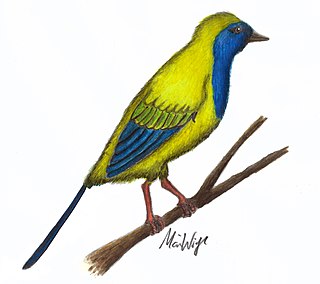
Liaoxiornis is a dubious genus of enantiornithine bird. The only named species is Liaoxiornis delicatus, described by Hou and Chen in 1999. Because the species was named for a hatchling specimen, it cannot be matched with adult specimens, and so it is impossible to determine which, if any, birds from the same rocks represent adults of this species. Luis Chiappe and colleagues therefore regarded it as a nomen vanum or at least a nomen dubium, and recommended that use of the name be abandoned.
Paratachardina pseudolobata, the lobate lac scale, is a polyphagous and pestiferous lac scale insect, which damages trees and woody shrubs in Cuba, Florida, the Bahamas and the Australian territory of Christmas Island. It was mistakenly identified as Paratachardina lobata (Chamberlin), an insect native to India and Sri Lanka, but was in 2007 recognized and named as a distinct species based on material from Florida; its native distribution is as yet unknown. The new lac insect was described based on all stages of the female, during the revision of the genus Paratachardina, wherein all its known species were redescribed.

Edward Ernest Green was an Ceylon-born English mycologist and entomologist who specialised in the scale-insects, Coccidae. An accomplished artist, and lithographer, he illustrated the five volume Coccidae of Ceylon.
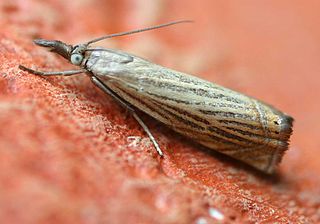
Chrysoteuchia is a genus of moths of the family Crambidae described by Jacob Hübner in 1825. Most are native to Asia.

Myriacantherpestes is an extinct genus of spiny millipedes from the Pennsylvanian subperiod of the Carboniferous period, known from fossils in Europe and North America.

Coccus is a genus of scale insects in the family Coccidae. Several species, such as Coccus viridis, a major pest of coffee, are major agricultural pests. The type species is Coccus hesperidumLinnaeus.
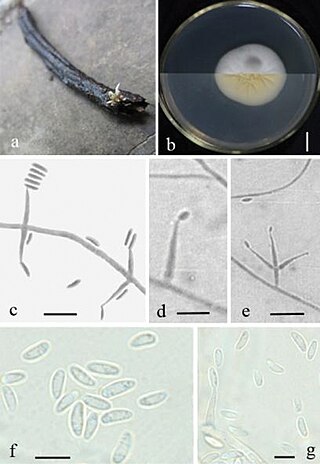
Lecanicillium is a genus of fungi in the order Hypocreales and is described as anamorphic Cordycipitaceae; 21 species are currently described. Some of these entomopathogenic fungus species were previously widely known as Verticillium lecanii (Zimmerman) Viegas. This genus was first named and introduced by Rasoul Zare (IRIPP) and Walter Gams (CBS).

Beesoniidae is a family of scale insects commonly known as beesoniids. They typically cause galls on their plant hosts. Members of this family mostly come from southern Asia. The family name comes from the type genus Beesonia which is named after the entomologist C.F.C. Beeson who obtained the specimens from which they were described and named.
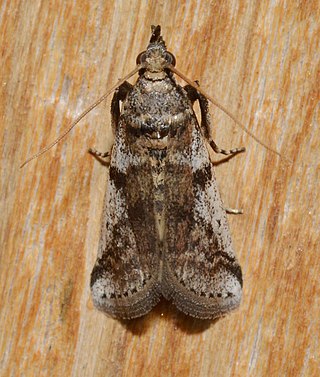
Laetilia coccidivora, the scale-feeding snout moth, is a species of snout moth in the genus Laetilia. It was described by John Henry Comstock in 1879.
Laetilia dilatifasciella is a species of snout moth in the genus Laetilia. It was described by Ragonot in 1887. It is found from southern New Mexico to southern California.
Coccus longulus, the long brown scale, is a species of soft scale insect in the family Coccidae. It is found in Europe.

Ceroplastes is a genus of wax scales in the family Coccidae. There are more than 130 described species in Ceroplastes.
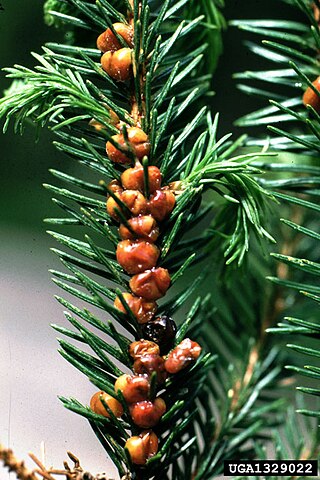
Physokermes are a genus of scale insects known as the bud scales. They are restricted to the Holarctic, though Physokermes hemicryphus has been introduced to North America. Some species are plant pests.

Zhangixalus is a genus of frogs in the subfamily Rhacophorinae, family Rhacophoridae. They are collectively known as Zhang's treefrogs. They occur in the Eastern Himalayas, southern China, Taiwan, Japan, and southeast Asia.

















